Thinking about a small dog? You might be weighing the Cavalier King Charles Spaniel against the Pomeranian.
Both breeds are crowd-pleasers with adorable looks and charming personalities. But, honestly, there are some real differences that matter.
Choosing between a Cavalier King Charles Spaniel and a Pomeranian depends on your lifestyle, living space, and how much grooming you can handle.
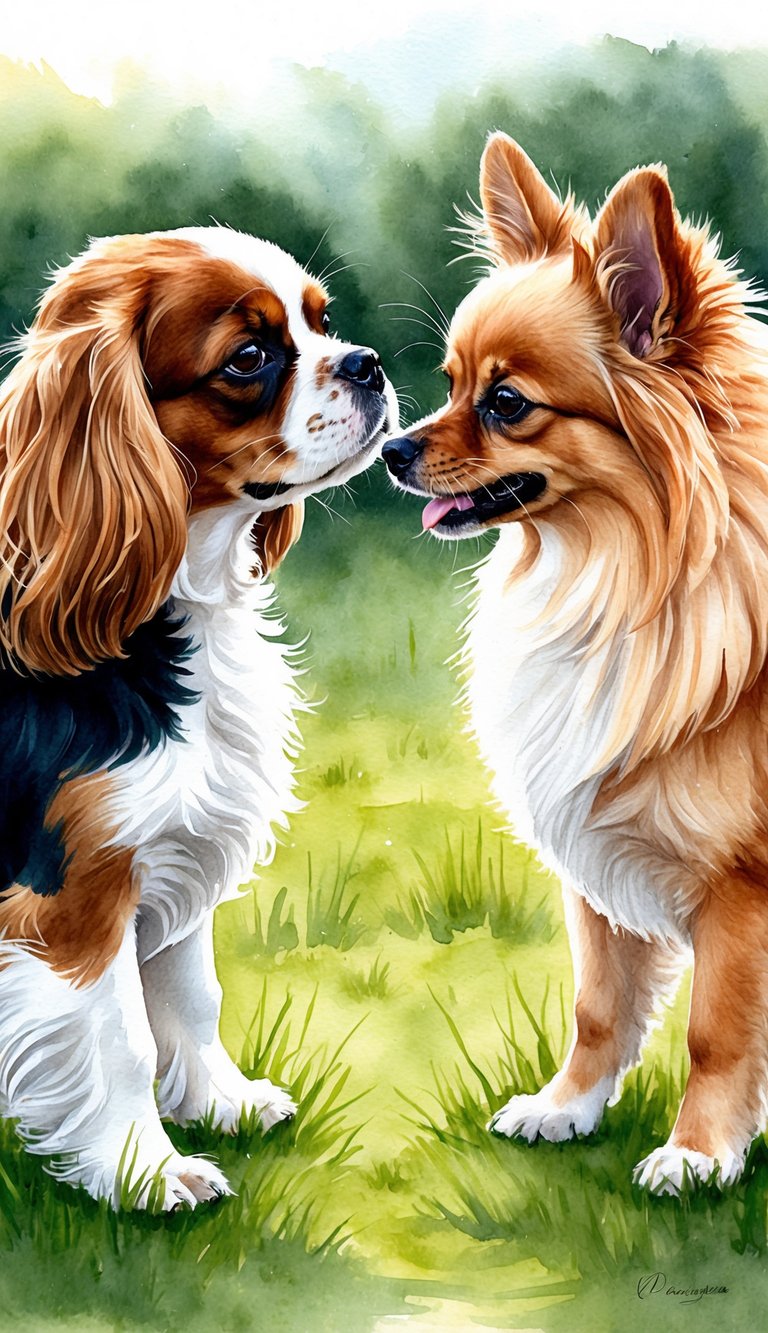
Both breeds are great companions. But their energy, grooming needs, and even health quirks can be pretty different.
You’ll also want to think about shedding, exercise, and how each breed might get along with kids or other pets.
Breed Origins and History
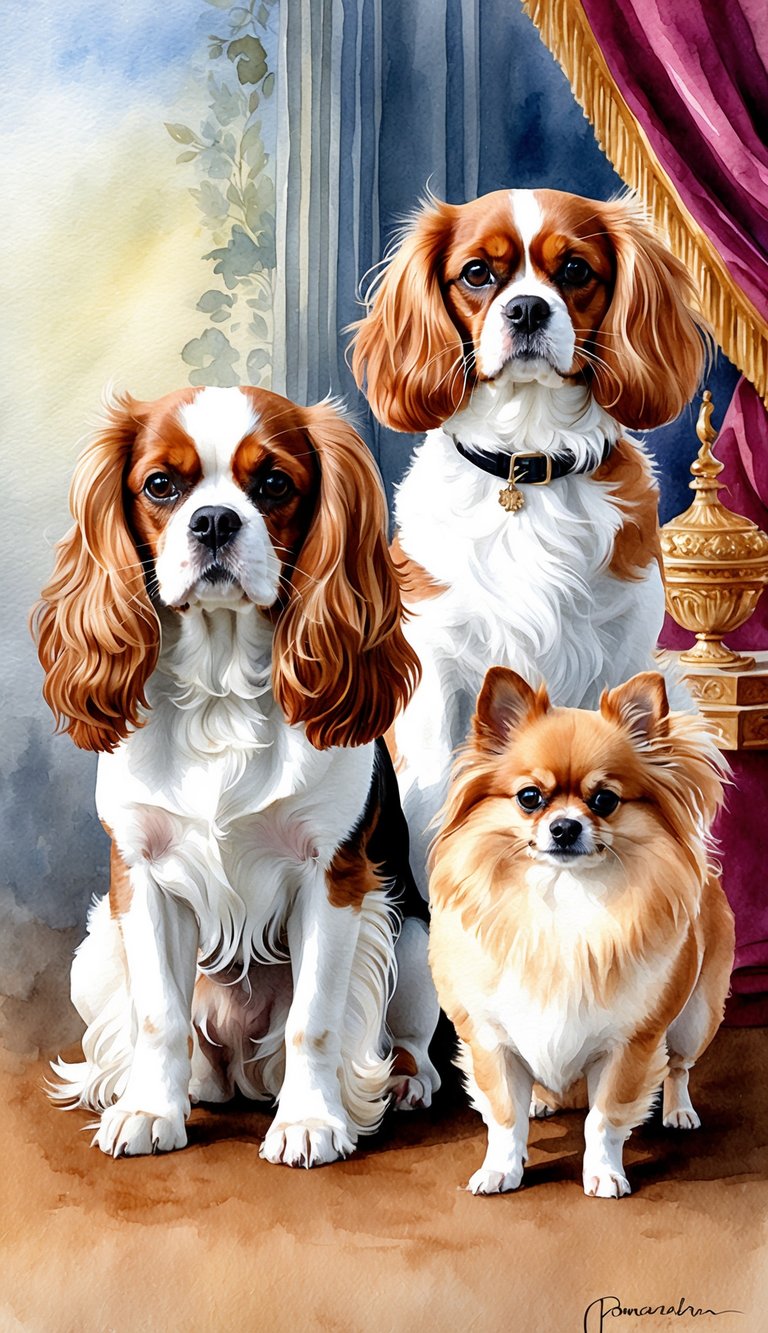
The Cavalier King Charles Spaniel and the Pomeranian both have interesting backstories. Each breed’s place in history shapes their personalities and looks.
Cavalier King Charles Spaniel Background
The Cavalier King Charles Spaniel has royal roots in England. British royalty, especially King Charles II, adored these dogs and kept them close as lap dogs.
They pop up in plenty of old paintings from the 16th and 17th centuries. Over the years, breeders focused on their gentle, affectionate side.
These dogs were bred to be companions, not hunters. Their soft nature made them perfect for laps in royal courts or busy homes.
People still love Cavaliers today for their friendly vibe and family-friendly attitude.
Pomeranian Heritage
Pomeranians started out in the region of Pomerania, now parts of Poland and Germany. Believe it or not, their ancestors were much bigger sled dogs.
Selective breeding shrank them down, but they kept their bold spirit. Queen Victoria helped make them famous in the 1800s.
Thanks to her, Poms became must-have pets for aristocrats. Their thick, fluffy coats and fox-like faces are hard to miss.
Pomeranians have a proud streak. They’re independent, sometimes loud, but affectionate all the same.
You’ll spot them in city apartments a lot because of their tiny size.
Comparison With Other Popular Toy Breeds
Both Cavalier King Charles Spaniels and Pomeranians belong to the toy breed group. They’re about the same size as other favorites, but their backstories are unique.
Here’s a quick table for a side-by-side look:
| Breed | Place of Origin | Original Purpose | Famous For |
|---|---|---|---|
| Cavalier King Charles Spaniel | England | Royal companion | Sweet temperament, royal history |
| Pomeranian | Pomerania (Poland/Germany) | Lapdog, alert watchdog | Fluffy coat, lively energy |
| Yorkshire Terrier | England | Ratting in mills | Silky hair, spunky personality |
| Toy Poodle | France/Germany | Circus performer, companion | Intelligence, hypoallergenic coat |
| Shih Tzu | China | Palace pet | Distinct face, loving nature |
| Maltese | Malta | Lapdog | Long white hair, gentle nature |
| Bichon Frise | Mediterranean | Companion dog | Curly coat, playful personality |
| Papillon | France/Belgium | Lapdog, companion | Butterfly-like ears, alertness |
Every toy breed brings something different. Some were royal favorites, while others started as working dogs or even circus stars.
Physical Appearance
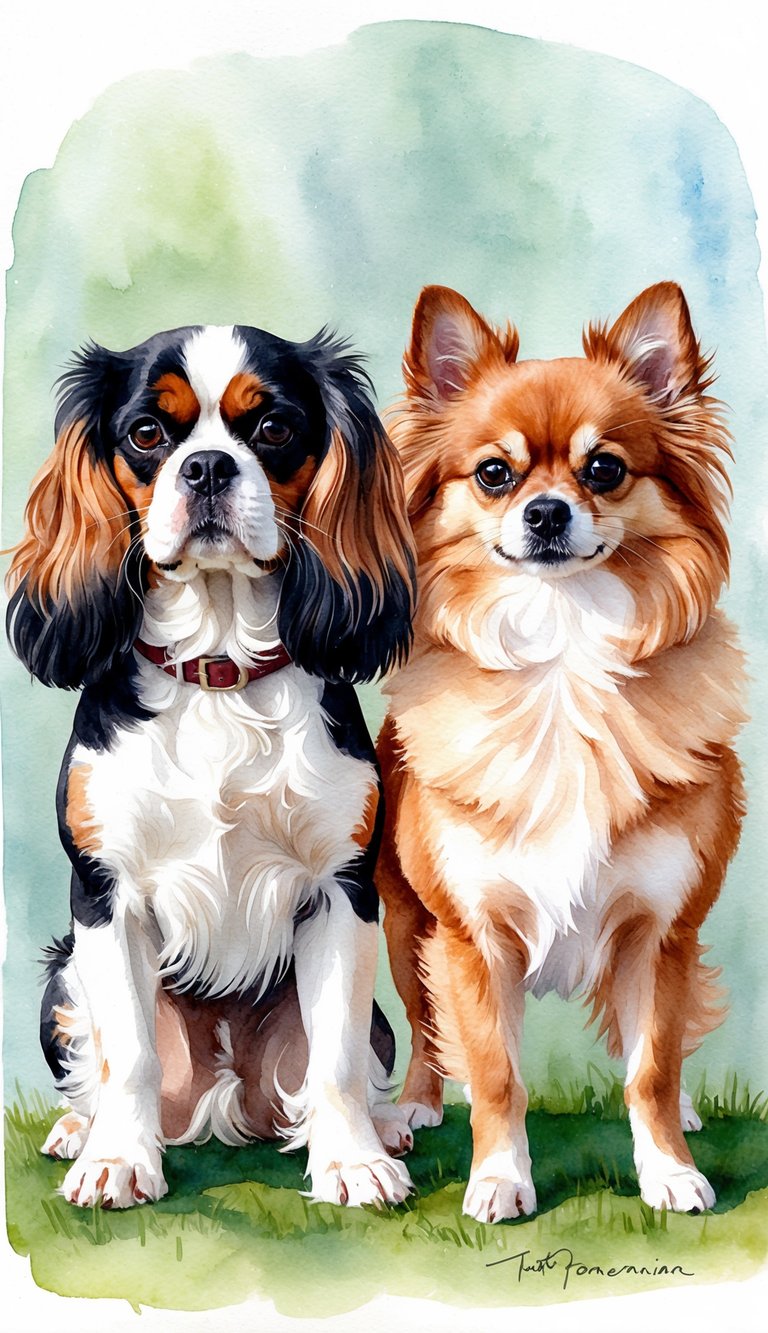
Cavalier King Charles Spaniels and Pomeranians each have a look that’s all their own. Their differences show up in size, coat, coloring, and face shape.
Size and Build Differences
The Cavalier King Charles Spaniel is definitely bigger than a Pomeranian. Most adult Cavaliers weigh 13 to 18 pounds and stand 12 to 13 inches tall at the shoulder.
They have a longer body and a sturdy build. Not as compact as Pomeranians, for sure.
The Pomeranian is a small toy breed. Adults usually weigh 3 to 7 pounds and stand 6 to 7 inches tall.
They’re compact and square-shaped. Their fluffy coats make them look even smaller sometimes.
You can usually tell who’s who just by looking at their size and posture. Cavaliers look soft and graceful, while Pomeranians are tiny and full of energy.
Coat Types and Colors
The Cavalier King Charles Spaniel has a long, silky coat. It’s flat or a little wavy, and feels smooth.
Their fur is longer on the ears, chest, feet, and tail. Common colors:
- Blenheim (chestnut and white)
- Tricolor (black, white, and tan)
- Ruby (solid red)
- Black and Tan
The Pomeranian has a double-layered coat. There’s a soft, dense undercoat and a long, fluffy outer coat that sticks out.
They come in tons of colors, like:
- Orange
- Black
- White
- Cream
- Blue
- Sable
- Red
- And many more
Pomeranians need more brushing because their thick fur tangles easily.
Breed Distinctive Features
Cavalier King Charles Spaniels stand out for their large, round eyes and long, feathered ears. Their faces are soft, with a gentle, almost sad look.
Pomeranians have a sharp, fox-like face. Their eyes are dark and alert, and their ears are small and upright.
Their pointed muzzle gives them a playful vibe. That thick, fluffy “ruff” around the neck? It’s like a mini lion’s mane.
Here’s a quick comparison:
| Feature | Cavalier King Charles Spaniel | Pomeranian |
|---|---|---|
| Ear Type | Long, feathered, floppy | Short, upright |
| Muzzle | Medium length, soft | Short, pointed |
| Tail | Feathery, carried level | Plumed, carried high |
| Eyes | Large, round, dark | Almond-shaped, dark |
You can usually spot the difference right away.
Temperament and Personality
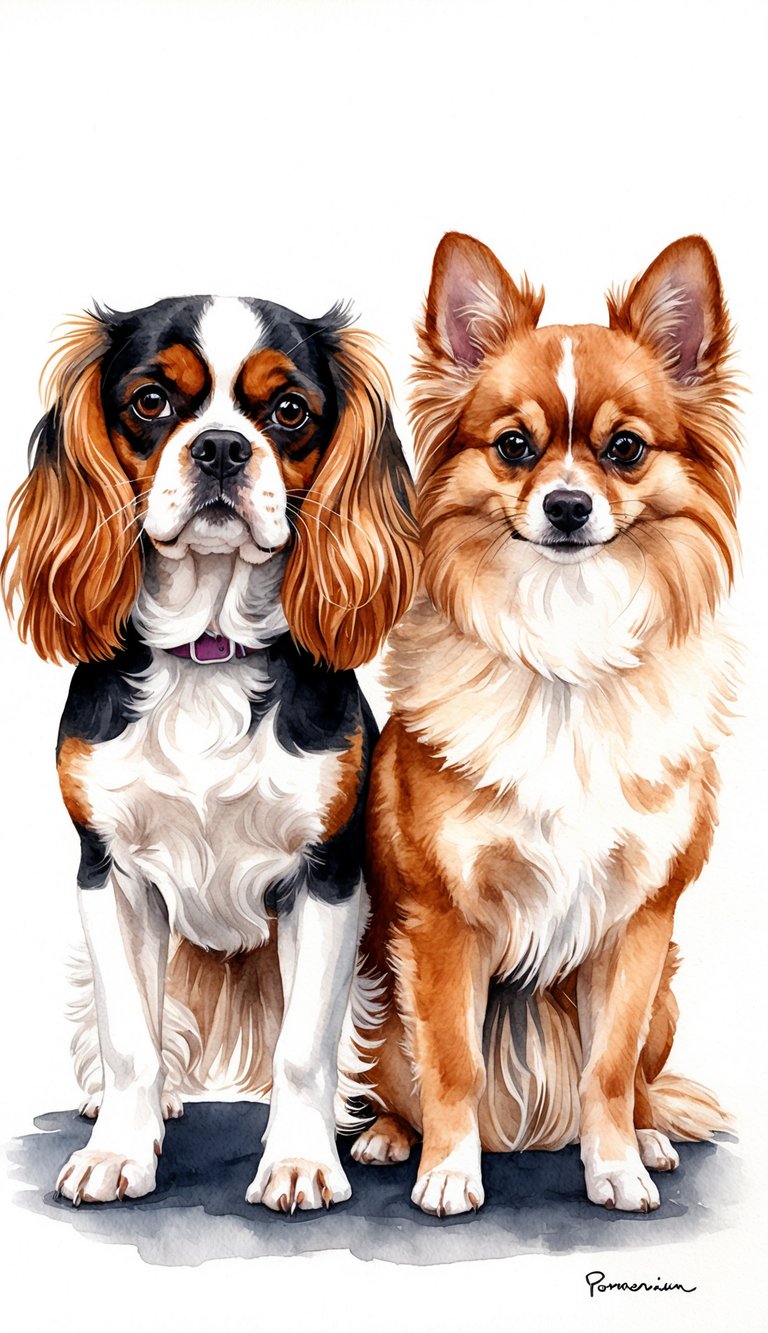
Cavalier King Charles Spaniels and Pomeranians both make popular companion dogs. But their personalities? Pretty different.
Affectionate Nature
Cavalier King Charles Spaniels are famously affectionate. They’re gentle, loving, and tend to stick close to their people.
These dogs love following you around. If you want a shadow, this is your breed.
Pomeranians are loving, too, but they’re a bit more independent. They enjoy attention and cuddles, but they’re also happy to do their own thing sometimes.
Poms can be vocal and outgoing, while Cavaliers are usually calm and eager to please.
If you want a constant snuggler, go for the Cavalier. If you like a spunky sidekick who’s loyal but not overly clingy, the Pomeranian might be more your style.
Compatibility With Families and Children
Cavalier King Charles Spaniels usually get along well with families, even those with young kids. Their gentle nature means they’re rarely snappy or aggressive.
This breed is patient, which is great for children. Pomeranians can do well with families, too, but their small size and high energy mean they might not love rough play from little kids.
They’re better for families with older children who can respect their space.
Quick summary:
| Breed | Best With |
|---|---|
| Cavalier | All ages, including younger children |
| Pomeranian | Families with older or gentle kids |
Your kids’ ages and personalities matter when picking a breed.
Behavior With Other Pets
Cavalier King Charles Spaniels usually get along with cats and other dogs. Their friendly nature means they rarely start fights or try to dominate.
Early socialization helps keep things smooth. Pomeranians can be bold around other animals.
Sometimes they’re a little bossy—even with bigger dogs. Slow introductions and supervision help, especially with small pets like hamsters or birds.
Both breeds benefit from early socialization. Cavaliers are more chill with new companions, while Pomeranians need a bit more guidance to avoid jealousy.
Exercise and Activity Needs

Both Cavalier King Charles Spaniels and Pomeranians are small, but their energy and exercise needs aren’t exactly the same. Keeping them active keeps them happier.
Daily Exercise Requirements
Cavalier King Charles Spaniels need daily walks. Try for at least 30 minutes a day.
They also enjoy playtime in a safe yard. Pomeranians are more about short bursts of energy.
Two or three short walks—about 15-20 minutes each—usually do the trick. Indoor play like fetch or tug-of-war is great for them.
| Breed | Daily Walks | Ideal Playtime |
|---|---|---|
| Cavalier King Charles | 30+ minutes | Interactive, yard play |
| Pomeranian | 15-20 min x 2-3 | Indoor games, short play |
Both breeds can handle apartment living if you give them daily walks and play. Routine helps keep them from getting restless.
Mental Stimulation and Enrichment
Cavalier King Charles Spaniels love training sessions, food puzzles, and gentle games. Teach them simple tricks or use treat-dispensing toys to keep their brains busy.
Pomeranians are smart and curious. They like interactive toys, hide-and-seek, and short training sessions.
Puzzle toys help stop boredom. Change up the games and toys to keep things interesting.
Without mental challenges, both breeds can get bored and start barking or chewing. Keep activities safe and sized for small dogs.
Grooming and Maintenance
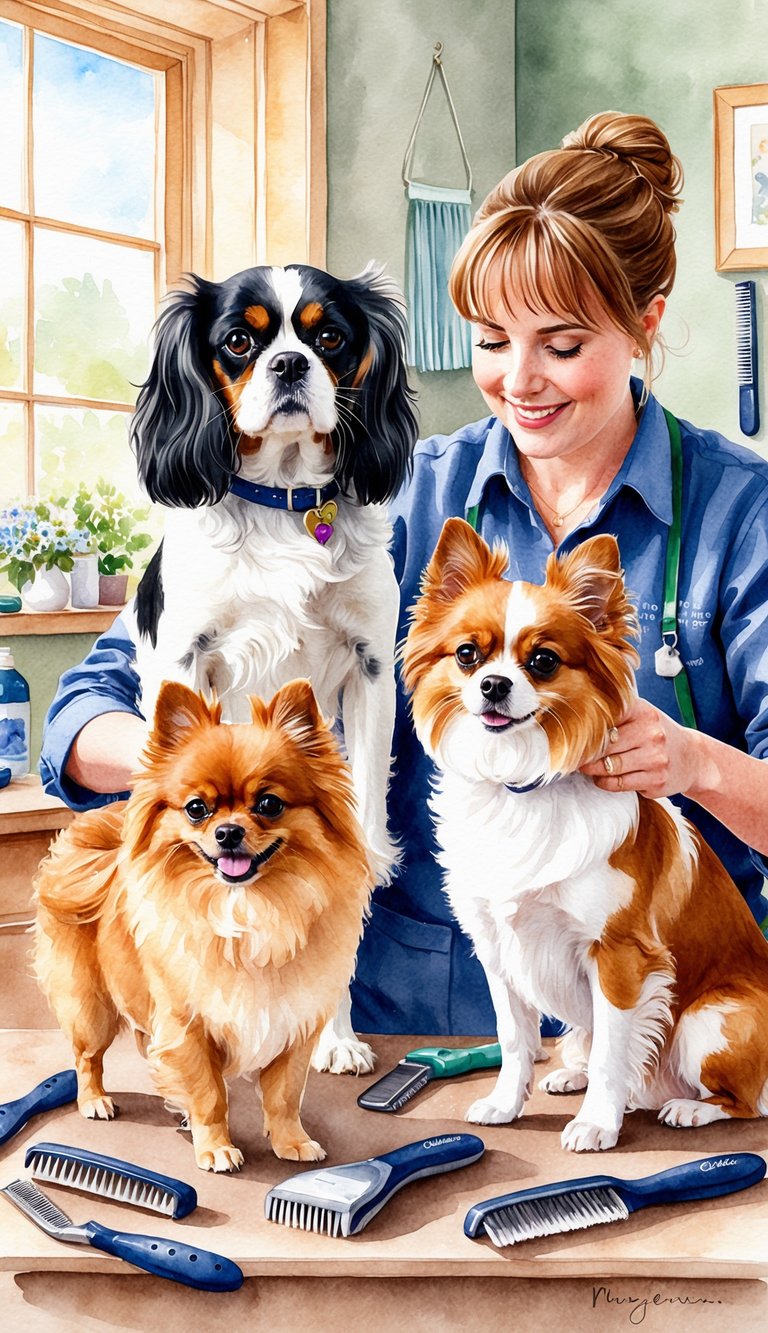
Cavalier King Charles Spaniels and Pomeranians both need regular grooming to stay clean and comfortable. Their coats are different, so their care routines aren’t quite the same.
Shedding and Coat Care
The Cavalier King Charles Spaniel sports a silky, medium-length coat. These dogs shed all year, but you’ll notice more fur dropping in spring and fall.
You should brush a Cavalier at least three times per week. Pay extra attention to the ears and chest, since their fur tends to mat there.
Pomeranians have a thick, double coat. Their shedding ramps up during seasonal changes.
Daily brushing is pretty much a must for Pomeranians. A slicker brush and metal comb help you get through that dense undercoat.
If you skip regular brushing, their fur mats up fast.
| Breed | Coat Type | Shedding | Brushing Frequency |
|---|---|---|---|
| Cavalier | Silky, medium-long | Medium | 3+ times per week |
| Pomeranian | Thick, double coat | High | Daily |
Bathing and Hygiene
Cavaliers only need a bath every 4–6 weeks—unless they find something messy to roll in. Use a gentle dog shampoo to keep their coat shiny and their skin comfortable.
Clean their ears each week and check for any dirt or signs of infection.
Pomeranians need baths every 3–4 weeks. Their double coat holds onto debris, so regular washing helps control odor and keeps shedding down.
Be sure to rinse out all the shampoo, or you’ll risk skin irritation.
Trim both breeds’ nails about twice a month. Brush their teeth several times a week to keep their mouths healthy.
Regular eye cleaning helps, too, since tear stains can pop up on both breeds.
Health Considerations

Cavalier King Charles Spaniels and Pomeranians both face some health concerns. Each breed has its own set of common issues, and their life expectancy depends on these risks.
Breed-Specific Health Issues
Cavalier King Charles Spaniels often deal with heart problems, especially mitral valve disease (MVD). MVD is a serious and common condition for this breed.
It affects the heart’s ability to pump blood, which can lead to heart failure. Cavaliers can also suffer from syringomyelia, where cavities form in the spinal cord near the brain.
Symptoms include neck pain and sensitivity. Other issues include ear infections and eye problems like cataracts.
Pomeranians are more likely to have dental issues because of their tiny mouths and crowded teeth. They’re also prone to tracheal collapse, which causes coughing and breathing trouble.
Other conditions you might see: luxating patella (slipping kneecaps), hypothyroidism, and hair loss (alopecia).
Regular vet visits and early treatment really matter for both breeds.
Lifespan and Longevity
Cavalier King Charles Spaniels usually live about 9 to 14 years. Heart disease, especially MVD, can shorten their lifespan if it shows up early.
A good diet, exercise, and prompt treatment for health problems help them live longer and healthier.
Pomeranians tend to live longer, often reaching 12 to 16 years. Their main threats are dental disease, tracheal collapse, and illnesses that come with age.
Regular dental care, a balanced diet, and plenty of exercise go a long way for your Pomeranian.
| Breed | Common Health Issues | Average Lifespan |
|---|---|---|
| Cavalier King Charles Spaniel | Mitral valve disease, syringomyelia, ear & eye problems | 9–14 years |
| Pomeranian | Dental disease, tracheal collapse, patella issues | 12–16 years |
Training and Intelligence

Both the Cavalier King Charles Spaniel and the Pomeranian are smart and eager to please. They respond well to training if you use patience and positive feedback.
Trainability and Learning Ability
The Cavalier King Charles Spaniel is usually easy to train. These dogs are gentle and want to make you happy, which helps them learn commands fast.
They’re clever, but sometimes get distracted if something more interesting pops up.
The Pomeranian is bright and curious, but also a bit stubborn. Their intelligence makes them quick to pick up basic commands and fun tricks.
Consistency and short training sessions work best. Pomeranians can lose interest if training drags on.
Both breeds love positive reinforcement like treats and praise. Harsh methods just make things worse—confusing or scaring them.
Ten to fifteen minutes a day is usually enough to see progress.
Socialization Tips
Getting your Cavalier King Charles Spaniel or Pomeranian used to different people and places early helps them become friendly and well-behaved.
Socialize your puppy by introducing it to other dogs, children, and everyday noises gradually.
For Pomeranians, who might act shy or bark at strangers, early socialization really matters. Encourage calm interactions and reward friendly behavior.
This helps prevent nipping or anxiety around new people.
With Cavaliers, focus on polite greetings and gentle handling. They usually get along well with others, but still need practice with manners outside the home.
Aim for a mix of new experiences each week to keep your dog comfortable and confident.
Suitability for Different Owners
Cavalier King Charles Spaniels and Pomeranians have unique needs and personalities. Your choice should match your home, lifestyle, and daily routine.
Best Living Environments
Cavalier King Charles Spaniels adapt well to different homes. They do well in both apartments and houses as long as they get daily walks and playtime.
These dogs love being close to their families and enjoy cozy, indoor settings.
Pomeranians also fit right into small homes, like apartments or condos. Their size makes them easy to manage in tight spaces.
But, they can be pretty vocal, so if you’ve got noise-sensitive neighbors, that’s something to think about.
Both breeds need to live indoors. Neither dog is cut out for long stints outside—they really thrive on human attention.
If you’ve got a busy household, Cavaliers tend to be calm and gentle. Pomeranians bring a lot of energy and alertness.
| Breed | Best for | Space Needed | Tolerance for Alone Time |
|---|---|---|---|
| Cavalier | Families, seniors | Moderate | Low |
| Pomeranian | Singles, couples | Very little | Low to moderate |
Travel and Urban Adaptability
If you travel a lot or live in the city, both breeds are pretty manageable. Cavaliers are relaxed and often enjoy car rides or short trips, as long as they’re with you.
They walk well on leashes and behave politely in public spaces.
Pomeranians, thanks to their tiny size (usually 3-7 pounds), are easy to carry in a bag or carrier. They fit into city life and can handle crowded sidewalks.
That said, they can get startled by loud, busy areas and may bark at new sounds and people.
Both breeds work for busy urban lives if you give them regular walks, playtime, and attention. If you’re taking the subway, bus, or plane, Pomeranians are especially portable.
Cavalier King Charles Spaniels are a bit bigger, but still small enough for most travel needs.
Breed Popularity and Comparison
Cavalier King Charles Spaniels and Pomeranians are both popular small dog breeds. They have different rankings, personalities, and characteristics when compared to other well-known small breeds.
Popularity Rankings
The Cavalier King Charles Spaniel usually lands in the top 20 to 25 breeds in the United States, according to the American Kennel Club (AKC). Folks love their calm nature and affection.
The Pomeranian is often ranked a bit higher, usually in the top 15 to 25. Pomeranians win people over with their bold personality and fluffy coats.
City dwellers and apartment folks seem to especially love them.
A quick look at 2024 AKC rankings:
| Breed | AKC Popularity (2024) |
|---|---|
| Pomeranian | #23 |
| Cavalier King Charles Spaniel | #19 |
| Chihuahua | #31 |
| Yorkshire Terrier | #14 |
| Cocker Spaniel | #29 |
Breed popularity shifts over time, but both Cavaliers and Pomeranians remain favorites in plenty of homes.
Comparison With Other Small Breeds
Pomeranians and Cavalier King Charles Spaniels go toe-to-toe with other small dog favorites like the Chihuahua, Yorkshire Terrier, Boston Terrier, and Pembroke Welsh Corgi.
Maybe you want a pup that doesn’t need much grooming—think Boston Terrier or French Bulldog. The Chihuahua is tinier, but it just can’t match that fluffy Pomeranian vibe.
The Yorkshire Terrier is about the same size but usually calls for more coat care. Cavalier King Charles Spaniels have a reputation for being gentle, kind of like Cocker Spaniels.
Looking for a sociable, lively little dog? The Pembroke Welsh Corgi or Beagle could be just the ticket.
Honestly, every breed brings something different to the table—energy, coat care, friendliness. It really comes down to what matters most to you and your crew.



